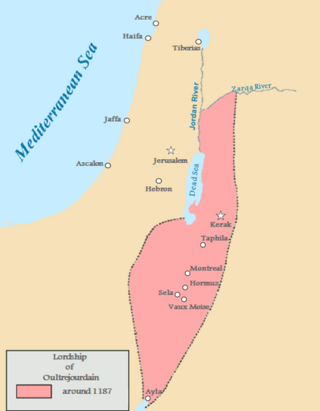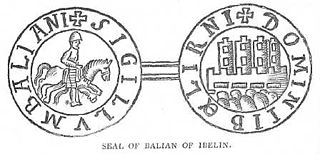
The Kingdom of Jerusalem, also known as the Crusader Kingdom, was one of the Crusader states established in the Levant immediately after the First Crusade. It lasted for almost two hundred years, from the accession of Godfrey of Bouillon in 1099 until the fall of Acre in 1291. Its history is divided into two periods with a brief interruption in its existence, beginning with its collapse after the siege of Jerusalem in 1187 and its restoration after the Third Crusade in 1192.

The Kingdom of Jerusalem, one of the Crusader states that was created in 1099, was divided into a number of smaller seigneuries. According to the 13th-century jurist John of Ibelin, the four highest crown vassals in the kingdom proper were the count of Jaffa and Ascalon, the prince of Galilee, the lord of Sidon, and the lord of Oultrejordain.

There were six major officers of the Kingdom of Jerusalem: the constable, the marshal, the seneschal, the chamberlain, the butler and the chancellor. At certain times there were also bailiffs, viscounts and castellans.

The Lordship of Transjordan was one of the principal lordships of the Kingdom of Jerusalem. It encompassed an extensive and partly undefined region to the east of the Jordan River, and was centered on the castles of Montreal and Kerak.

The king or queen of Jerusalem was the supreme ruler of the Kingdom of Jerusalem, a Crusader state founded in Jerusalem by the Latin Catholic leaders of the First Crusade, when the city was conquered in 1099. Most of them were men, but there were also five queens regnant of Jerusalem, either reigning alone suo jure, or as co-rulers of husbands who reigned as kings of Jerusalem jure uxoris.

The House of Ibelin was a noble family in the Crusader Kingdom of Jerusalem in the 12th century. They rose from relatively humble beginnings to become one of the most important families in the kingdom, holding various high offices and with extensive holdings in the Holy Land and Cyprus. The family disappeared after the fall of the Kingdom of Cyprus in the 15th century.
Barisan of Ibelin was the first lord of Ibelin and the founder of the House of Ibelin in the crusader Kingdom of Jerusalem. His name was later written as "Balian" and he is sometimes known as Balian the Elder, Barisan the Old or Balian I. Barisan was also lord of Ramla from 1138 to 1150.
Hugh of Ibelin was an important noble in the Kingdom of Jerusalem and was Lord of Ramla from 1152-1169.
Baldwin of Ibelin, also known as Baldwin II of Ramla, was an important noble of the Kingdom of Jerusalem in the 12th century and was lord of Ramla from 1169-1186. He was the second son of Barisan of Ibelin, and was the younger brother of Hugh of Ibelin and older brother of Balian of Ibelin. He first appears in the historical record as a witness to charters in 1148.

Balian of Ibelin, also known as Barisan the Younger, was a crusader noble of the Kingdom of Jerusalem in the 12th century. He was Lord of Ibelin from 1170 to 1193. As the leader of the defense of the city during the siege of Jerusalem in 1187, he surrendered Jerusalem to Saladin on 2 October 1187.

Hugh II, also called Hugh du Puiset, was a Crusader and the count of Jaffa in the Kingdom of Jerusalem. He revolted against King Fulk in 1134.

The double County of Jaffa and Ascalon was one of the four major seigneuries comprising the major Crusader state of the Kingdom of Jerusalem, according to 13th-century commentator John of Ibelin.

The principality of Galilee was one of the four major seigneuries of the crusader Kingdom of Jerusalem, according to 13th-century commentator John of Ibelin, grandson of Balian. The direct holdings of the principality centred around Tiberias, in Galilee proper, but with all its vassals, the lordship covered all Galilee and southern Phoenicia. The independent Lordship of Sidon was located between Galilee's holdings. The principality also had its own vassals: the Lordships of Beirut, Nazareth, and Haifa.
The Lordship of Sidon, later County of Sidon, was one of the four major fiefdoms of the Kingdom of Jerusalem, one of the Crusader States. However, in reality, it appears to have been much smaller than the others and had the same level of significance as several neighbors, such as Toron and Beirut, which were sub-vassals.
Manasses of Hierges was an important crusader and constable of the Kingdom of Jerusalem. He was lord of Ramla from 1150 to 1152.
Eustace I Granier, also known as Eustace Grenier or Eustace Garnier, called in Latin Eustachius Granarius in the charters, was a Flemish crusader who took part in the First Crusade. He became lord of Caesarea in 1101 and lord of Sidon in 1110. On 18 April 1123, he was elected constable and bailiff of Jerusalem during the captivity of Baldwin II of Jerusalem. Shortly before his death, he defeated a Fatimid army at the Battle of Yibneh near Ibelin.
Eustace Grenier is quoted in a text in verse written during his life in honour of the knights of the diocese of Thérouanne who accompanied Baldwin of Boulogne to the Holy Land.
Contemporary authors and historians identify Eustace Grenier as a nobleman from the diocese of Thérouanne in the County of Saint-Pol. Alan V. Murray, historian of the Crusades, writes: "However, his origins can be established with a high degree of certainty. The Versus de viris illustribus diocesis Tarvanensis qui in sacra fuere expeditione identifies him as a Fleming from the diocese of Therouanne".
Baldwin I was the castellan and lord of Ramla in the Kingdom of Jerusalem from 1106 to his death. In 1120, he participated in the Council of Nablus. In 1126, the castellany, which controlled the surrounding countryside too, was given in fief to the Count of Jaffa. In 1134, Jaffa was confiscated to the king after the rebellion of Hugh II and Ramla was given to Baldwin, to hold from the count of Jaffa.
The Lordship of Beirut was a feudal lordship in the Kingdom of Jerusalem centered on the city of Beirut. In the 12th century it was ruled by the Brisebarre family. At some point between 1165 and 1174, Beirut was taken back into the royal domain. Count Raymond III of Tripoli held it in 1185-86, and in 1187 it was conquered by the Ayyubids. It was recovered in 1197, and in the 13th century the lordship was held by the Ibelin family.
The House of Granier was a prominent noble family during the Crusades founded at the beginning of the 12th century by Eustachius Granarius, a Flemish nobleman from the Diocese of Thérouanne in the County of Saint-Pol who became lord of Sidon and Caesarea near 1110.
Helvis of Ramla was the lady of Ramla in the crusader Kingdom of Jerusalem, and a progenitor of the prominent Ibelin family.